Emergency Management in Healthcare: NHS Role and Responsibilities
VerifiedAdded on 2021/02/20
|13
|3403
|105
Report
AI Summary
This report delves into the realm of integrated emergency management within the National Health Service (NHS), the UK's publicly funded healthcare system. It examines the legislative and guiding frameworks that govern public services' responses to emergency incidents, particularly the Civil Contingencies Act 2004. The report defines statutory responsibilities in emergency planning and response, outlining the NHS's crucial role in prevention, preparedness, mitigation, response, and recovery. It highlights the importance of collaboration with other agencies, including military responders. Furthermore, the report identifies key considerations for public services when formulating emergency plans, encompassing prevention, mitigation, and response strategies. The report underscores the significance of effective planning to minimize the impacts of emergencies and ensure community well-being.
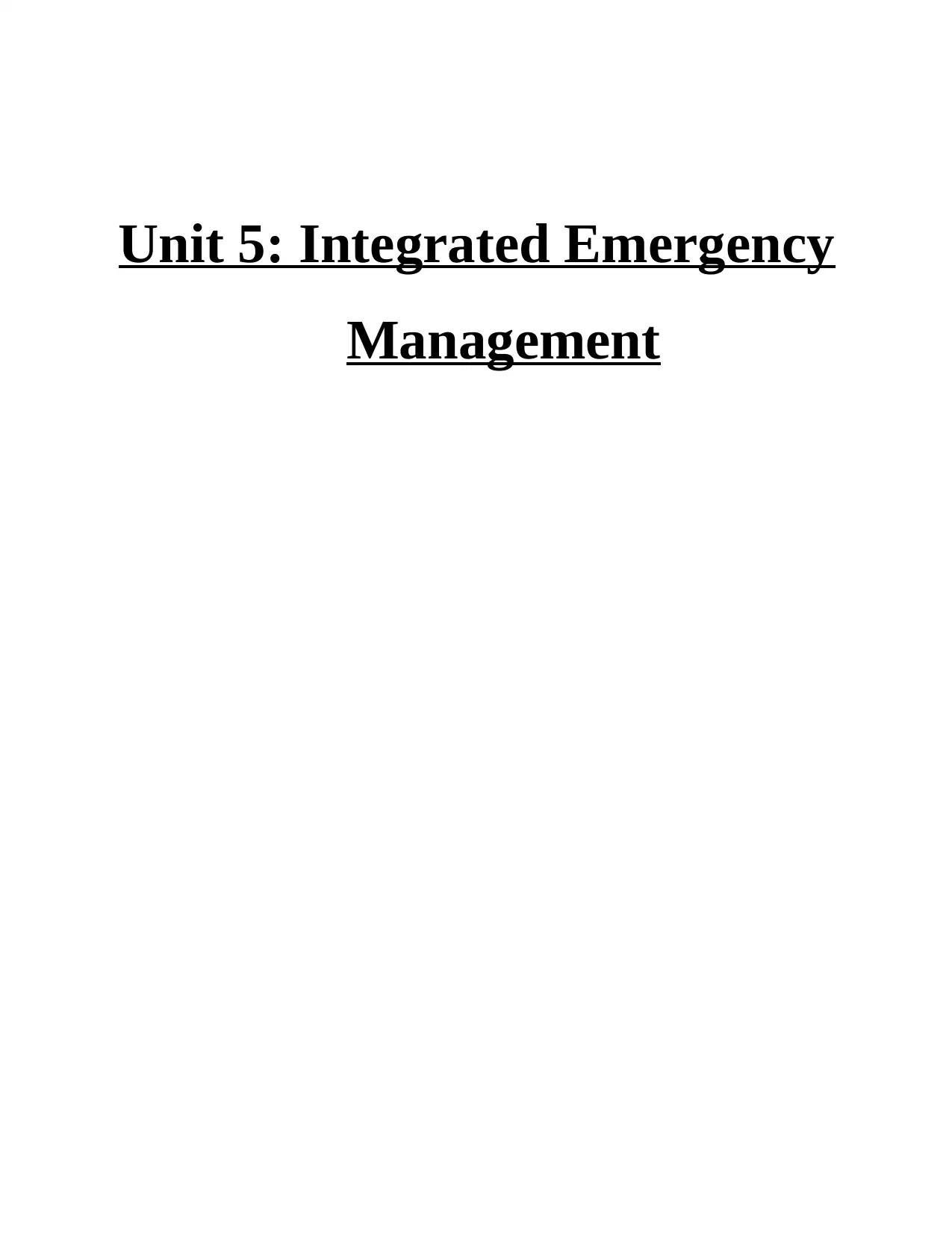
Unit 5: Integrated Emergency
Management
Management
Paraphrase This Document
Need a fresh take? Get an instant paraphrase of this document with our AI Paraphraser
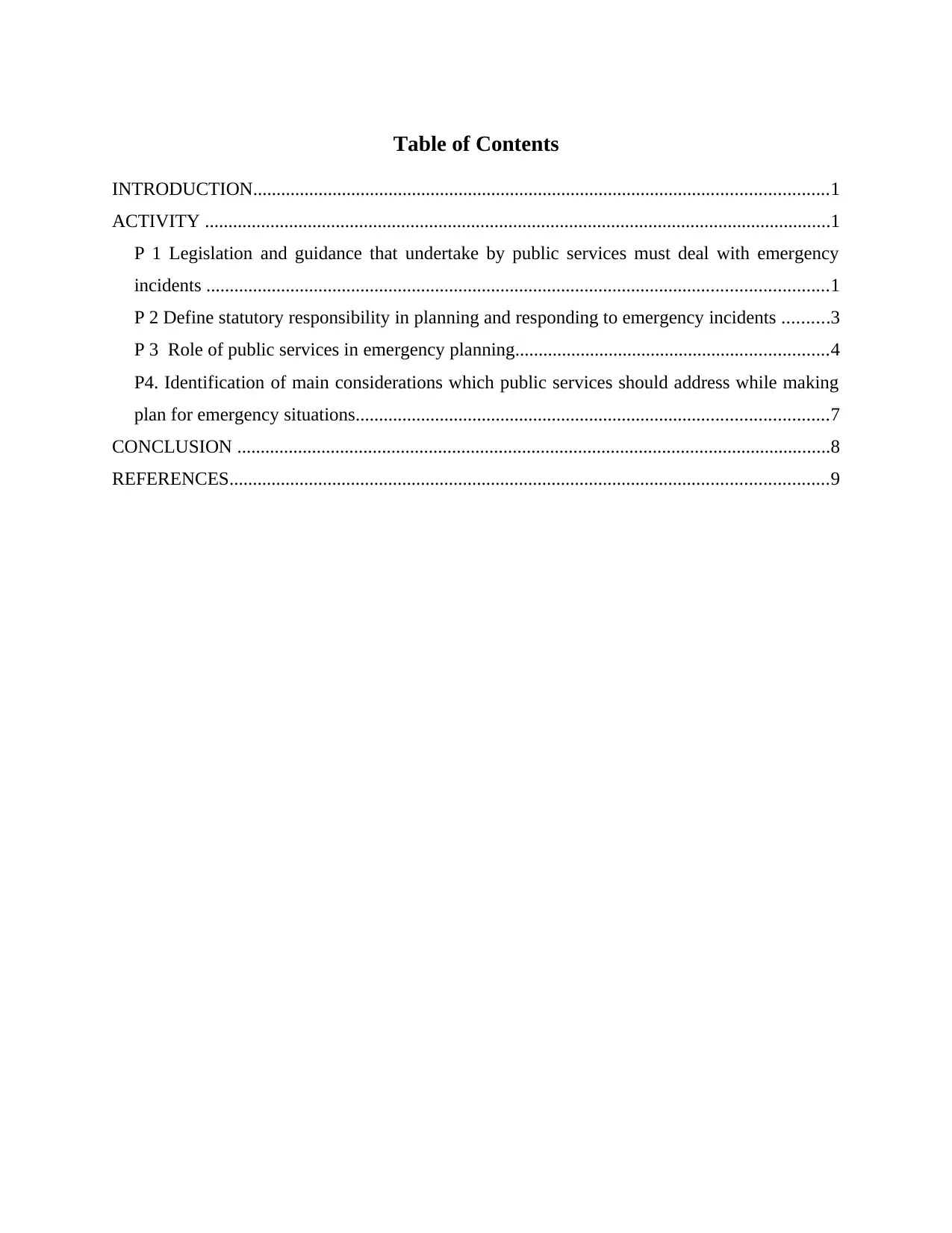
Table of Contents
INTRODUCTION...........................................................................................................................1
ACTIVITY ......................................................................................................................................1
P 1 Legislation and guidance that undertake by public services must deal with emergency
incidents .....................................................................................................................................1
P 2 Define statutory responsibility in planning and responding to emergency incidents ..........3
P 3 Role of public services in emergency planning...................................................................4
P4. Identification of main considerations which public services should address while making
plan for emergency situations.....................................................................................................7
CONCLUSION ...............................................................................................................................8
REFERENCES................................................................................................................................9
INTRODUCTION...........................................................................................................................1
ACTIVITY ......................................................................................................................................1
P 1 Legislation and guidance that undertake by public services must deal with emergency
incidents .....................................................................................................................................1
P 2 Define statutory responsibility in planning and responding to emergency incidents ..........3
P 3 Role of public services in emergency planning...................................................................4
P4. Identification of main considerations which public services should address while making
plan for emergency situations.....................................................................................................7
CONCLUSION ...............................................................................................................................8
REFERENCES................................................................................................................................9

⊘ This is a preview!⊘
Do you want full access?
Subscribe today to unlock all pages.

Trusted by 1+ million students worldwide
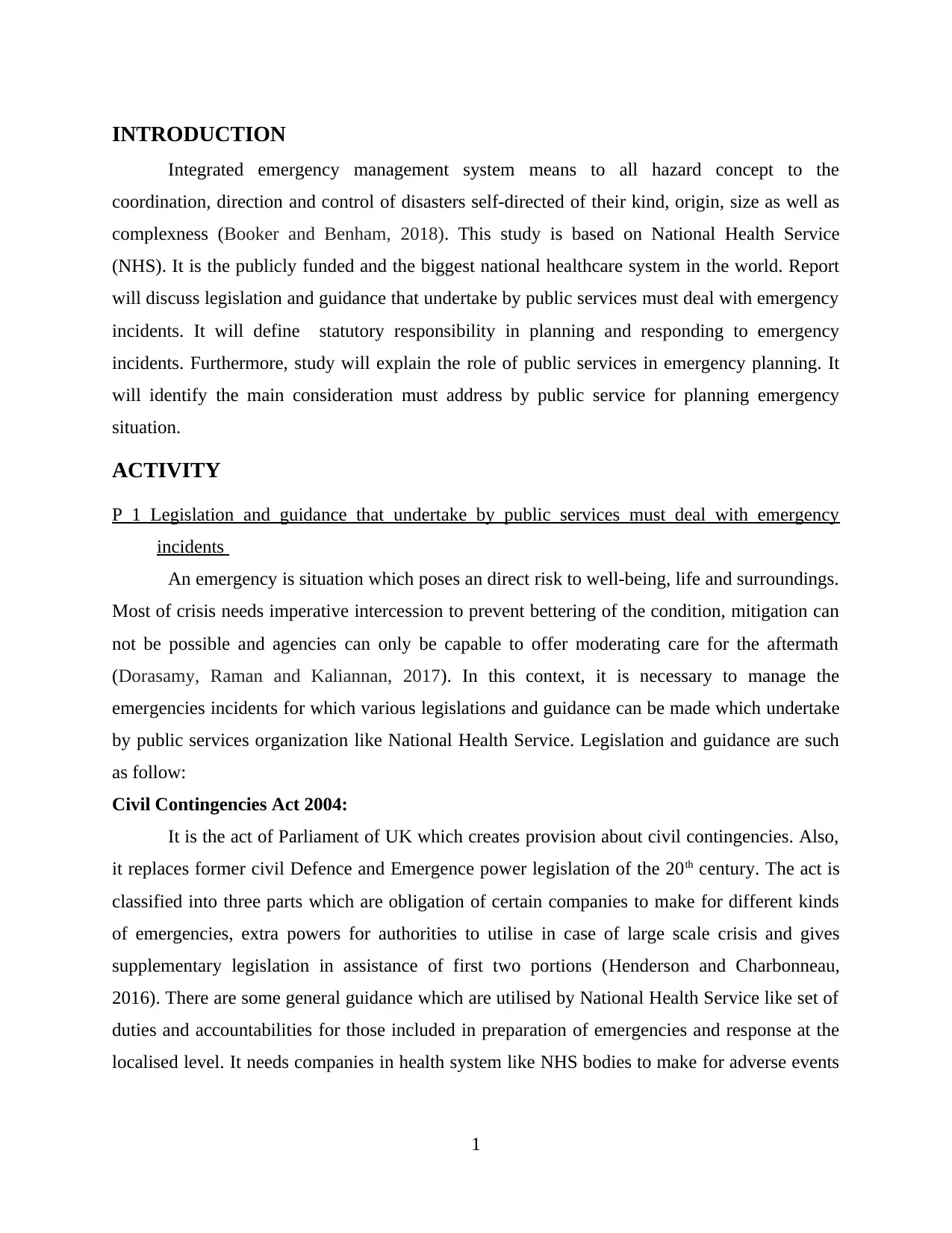
INTRODUCTION
Integrated emergency management system means to all hazard concept to the
coordination, direction and control of disasters self-directed of their kind, origin, size as well as
complexness (Booker and Benham, 2018). This study is based on National Health Service
(NHS). It is the publicly funded and the biggest national healthcare system in the world. Report
will discuss legislation and guidance that undertake by public services must deal with emergency
incidents. It will define statutory responsibility in planning and responding to emergency
incidents. Furthermore, study will explain the role of public services in emergency planning. It
will identify the main consideration must address by public service for planning emergency
situation.
ACTIVITY
P 1 Legislation and guidance that undertake by public services must deal with emergency
incidents
An emergency is situation which poses an direct risk to well-being, life and surroundings.
Most of crisis needs imperative intercession to prevent bettering of the condition, mitigation can
not be possible and agencies can only be capable to offer moderating care for the aftermath
(Dorasamy, Raman and Kaliannan, 2017). In this context, it is necessary to manage the
emergencies incidents for which various legislations and guidance can be made which undertake
by public services organization like National Health Service. Legislation and guidance are such
as follow:
Civil Contingencies Act 2004:
It is the act of Parliament of UK which creates provision about civil contingencies. Also,
it replaces former civil Defence and Emergence power legislation of the 20th century. The act is
classified into three parts which are obligation of certain companies to make for different kinds
of emergencies, extra powers for authorities to utilise in case of large scale crisis and gives
supplementary legislation in assistance of first two portions (Henderson and Charbonneau,
2016). There are some general guidance which are utilised by National Health Service like set of
duties and accountabilities for those included in preparation of emergencies and response at the
localised level. It needs companies in health system like NHS bodies to make for adverse events
1
Integrated emergency management system means to all hazard concept to the
coordination, direction and control of disasters self-directed of their kind, origin, size as well as
complexness (Booker and Benham, 2018). This study is based on National Health Service
(NHS). It is the publicly funded and the biggest national healthcare system in the world. Report
will discuss legislation and guidance that undertake by public services must deal with emergency
incidents. It will define statutory responsibility in planning and responding to emergency
incidents. Furthermore, study will explain the role of public services in emergency planning. It
will identify the main consideration must address by public service for planning emergency
situation.
ACTIVITY
P 1 Legislation and guidance that undertake by public services must deal with emergency
incidents
An emergency is situation which poses an direct risk to well-being, life and surroundings.
Most of crisis needs imperative intercession to prevent bettering of the condition, mitigation can
not be possible and agencies can only be capable to offer moderating care for the aftermath
(Dorasamy, Raman and Kaliannan, 2017). In this context, it is necessary to manage the
emergencies incidents for which various legislations and guidance can be made which undertake
by public services organization like National Health Service. Legislation and guidance are such
as follow:
Civil Contingencies Act 2004:
It is the act of Parliament of UK which creates provision about civil contingencies. Also,
it replaces former civil Defence and Emergence power legislation of the 20th century. The act is
classified into three parts which are obligation of certain companies to make for different kinds
of emergencies, extra powers for authorities to utilise in case of large scale crisis and gives
supplementary legislation in assistance of first two portions (Henderson and Charbonneau,
2016). There are some general guidance which are utilised by National Health Service like set of
duties and accountabilities for those included in preparation of emergencies and response at the
localised level. It needs companies in health system like NHS bodies to make for adverse events
1
Paraphrase This Document
Need a fresh take? Get an instant paraphrase of this document with our AI Paraphraser
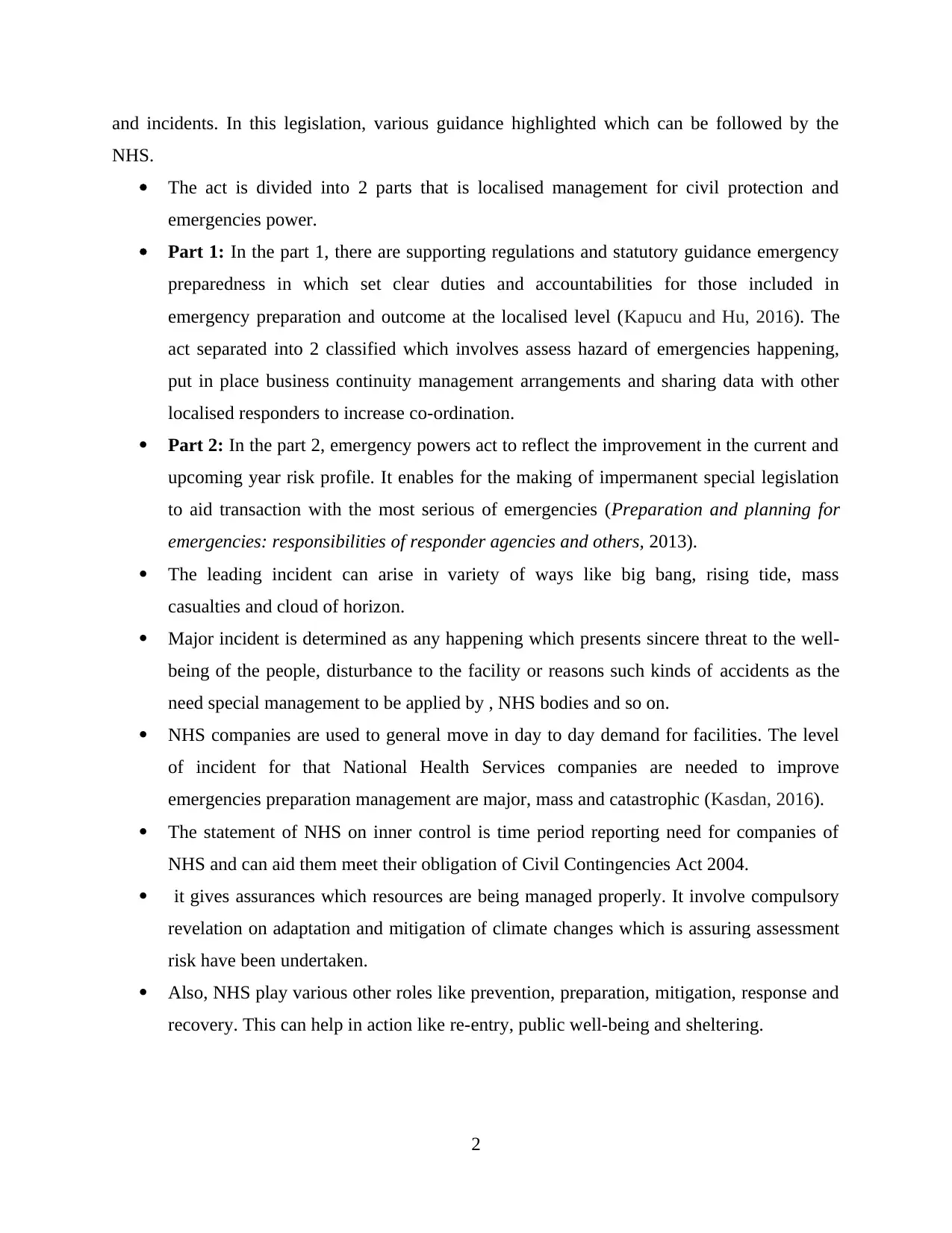
and incidents. In this legislation, various guidance highlighted which can be followed by the
NHS.
The act is divided into 2 parts that is localised management for civil protection and
emergencies power.
Part 1: In the part 1, there are supporting regulations and statutory guidance emergency
preparedness in which set clear duties and accountabilities for those included in
emergency preparation and outcome at the localised level (Kapucu and Hu, 2016). The
act separated into 2 classified which involves assess hazard of emergencies happening,
put in place business continuity management arrangements and sharing data with other
localised responders to increase co-ordination.
Part 2: In the part 2, emergency powers act to reflect the improvement in the current and
upcoming year risk profile. It enables for the making of impermanent special legislation
to aid transaction with the most serious of emergencies (Preparation and planning for
emergencies: responsibilities of responder agencies and others, 2013).
The leading incident can arise in variety of ways like big bang, rising tide, mass
casualties and cloud of horizon.
Major incident is determined as any happening which presents sincere threat to the well-
being of the people, disturbance to the facility or reasons such kinds of accidents as the
need special management to be applied by , NHS bodies and so on.
NHS companies are used to general move in day to day demand for facilities. The level
of incident for that National Health Services companies are needed to improve
emergencies preparation management are major, mass and catastrophic (Kasdan, 2016).
The statement of NHS on inner control is time period reporting need for companies of
NHS and can aid them meet their obligation of Civil Contingencies Act 2004.
it gives assurances which resources are being managed properly. It involve compulsory
revelation on adaptation and mitigation of climate changes which is assuring assessment
risk have been undertaken.
Also, NHS play various other roles like prevention, preparation, mitigation, response and
recovery. This can help in action like re-entry, public well-being and sheltering.
2
NHS.
The act is divided into 2 parts that is localised management for civil protection and
emergencies power.
Part 1: In the part 1, there are supporting regulations and statutory guidance emergency
preparedness in which set clear duties and accountabilities for those included in
emergency preparation and outcome at the localised level (Kapucu and Hu, 2016). The
act separated into 2 classified which involves assess hazard of emergencies happening,
put in place business continuity management arrangements and sharing data with other
localised responders to increase co-ordination.
Part 2: In the part 2, emergency powers act to reflect the improvement in the current and
upcoming year risk profile. It enables for the making of impermanent special legislation
to aid transaction with the most serious of emergencies (Preparation and planning for
emergencies: responsibilities of responder agencies and others, 2013).
The leading incident can arise in variety of ways like big bang, rising tide, mass
casualties and cloud of horizon.
Major incident is determined as any happening which presents sincere threat to the well-
being of the people, disturbance to the facility or reasons such kinds of accidents as the
need special management to be applied by , NHS bodies and so on.
NHS companies are used to general move in day to day demand for facilities. The level
of incident for that National Health Services companies are needed to improve
emergencies preparation management are major, mass and catastrophic (Kasdan, 2016).
The statement of NHS on inner control is time period reporting need for companies of
NHS and can aid them meet their obligation of Civil Contingencies Act 2004.
it gives assurances which resources are being managed properly. It involve compulsory
revelation on adaptation and mitigation of climate changes which is assuring assessment
risk have been undertaken.
Also, NHS play various other roles like prevention, preparation, mitigation, response and
recovery. This can help in action like re-entry, public well-being and sheltering.
2
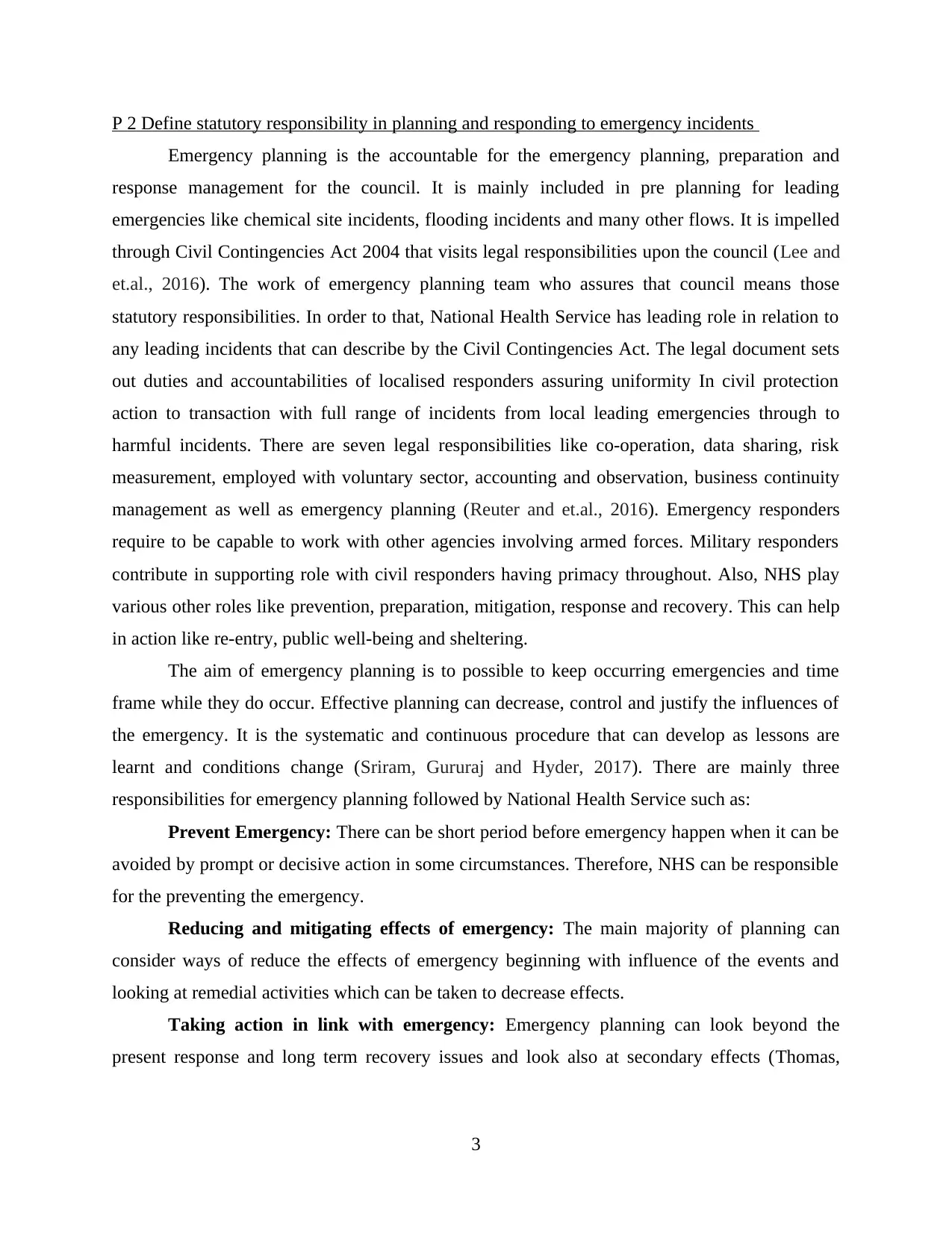
P 2 Define statutory responsibility in planning and responding to emergency incidents
Emergency planning is the accountable for the emergency planning, preparation and
response management for the council. It is mainly included in pre planning for leading
emergencies like chemical site incidents, flooding incidents and many other flows. It is impelled
through Civil Contingencies Act 2004 that visits legal responsibilities upon the council (Lee and
et.al., 2016). The work of emergency planning team who assures that council means those
statutory responsibilities. In order to that, National Health Service has leading role in relation to
any leading incidents that can describe by the Civil Contingencies Act. The legal document sets
out duties and accountabilities of localised responders assuring uniformity In civil protection
action to transaction with full range of incidents from local leading emergencies through to
harmful incidents. There are seven legal responsibilities like co-operation, data sharing, risk
measurement, employed with voluntary sector, accounting and observation, business continuity
management as well as emergency planning (Reuter and et.al., 2016). Emergency responders
require to be capable to work with other agencies involving armed forces. Military responders
contribute in supporting role with civil responders having primacy throughout. Also, NHS play
various other roles like prevention, preparation, mitigation, response and recovery. This can help
in action like re-entry, public well-being and sheltering.
The aim of emergency planning is to possible to keep occurring emergencies and time
frame while they do occur. Effective planning can decrease, control and justify the influences of
the emergency. It is the systematic and continuous procedure that can develop as lessons are
learnt and conditions change (Sriram, Gururaj and Hyder, 2017). There are mainly three
responsibilities for emergency planning followed by National Health Service such as:
Prevent Emergency: There can be short period before emergency happen when it can be
avoided by prompt or decisive action in some circumstances. Therefore, NHS can be responsible
for the preventing the emergency.
Reducing and mitigating effects of emergency: The main majority of planning can
consider ways of reduce the effects of emergency beginning with influence of the events and
looking at remedial activities which can be taken to decrease effects.
Taking action in link with emergency: Emergency planning can look beyond the
present response and long term recovery issues and look also at secondary effects (Thomas,
3
Emergency planning is the accountable for the emergency planning, preparation and
response management for the council. It is mainly included in pre planning for leading
emergencies like chemical site incidents, flooding incidents and many other flows. It is impelled
through Civil Contingencies Act 2004 that visits legal responsibilities upon the council (Lee and
et.al., 2016). The work of emergency planning team who assures that council means those
statutory responsibilities. In order to that, National Health Service has leading role in relation to
any leading incidents that can describe by the Civil Contingencies Act. The legal document sets
out duties and accountabilities of localised responders assuring uniformity In civil protection
action to transaction with full range of incidents from local leading emergencies through to
harmful incidents. There are seven legal responsibilities like co-operation, data sharing, risk
measurement, employed with voluntary sector, accounting and observation, business continuity
management as well as emergency planning (Reuter and et.al., 2016). Emergency responders
require to be capable to work with other agencies involving armed forces. Military responders
contribute in supporting role with civil responders having primacy throughout. Also, NHS play
various other roles like prevention, preparation, mitigation, response and recovery. This can help
in action like re-entry, public well-being and sheltering.
The aim of emergency planning is to possible to keep occurring emergencies and time
frame while they do occur. Effective planning can decrease, control and justify the influences of
the emergency. It is the systematic and continuous procedure that can develop as lessons are
learnt and conditions change (Sriram, Gururaj and Hyder, 2017). There are mainly three
responsibilities for emergency planning followed by National Health Service such as:
Prevent Emergency: There can be short period before emergency happen when it can be
avoided by prompt or decisive action in some circumstances. Therefore, NHS can be responsible
for the preventing the emergency.
Reducing and mitigating effects of emergency: The main majority of planning can
consider ways of reduce the effects of emergency beginning with influence of the events and
looking at remedial activities which can be taken to decrease effects.
Taking action in link with emergency: Emergency planning can look beyond the
present response and long term recovery issues and look also at secondary effects (Thomas,
3
⊘ This is a preview!⊘
Do you want full access?
Subscribe today to unlock all pages.

Trusted by 1+ million students worldwide
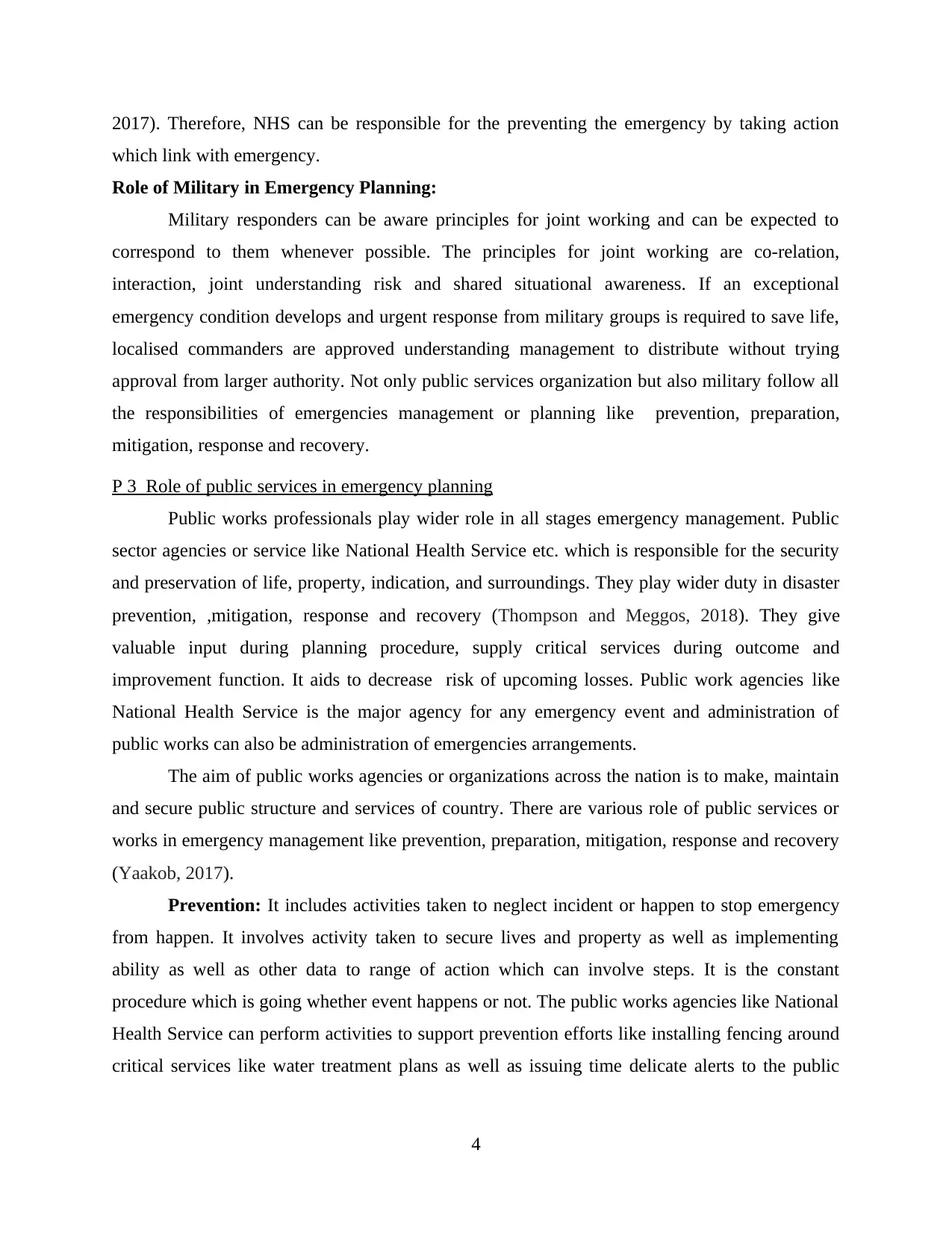
2017). Therefore, NHS can be responsible for the preventing the emergency by taking action
which link with emergency.
Role of Military in Emergency Planning:
Military responders can be aware principles for joint working and can be expected to
correspond to them whenever possible. The principles for joint working are co-relation,
interaction, joint understanding risk and shared situational awareness. If an exceptional
emergency condition develops and urgent response from military groups is required to save life,
localised commanders are approved understanding management to distribute without trying
approval from larger authority. Not only public services organization but also military follow all
the responsibilities of emergencies management or planning like prevention, preparation,
mitigation, response and recovery.
P 3 Role of public services in emergency planning
Public works professionals play wider role in all stages emergency management. Public
sector agencies or service like National Health Service etc. which is responsible for the security
and preservation of life, property, indication, and surroundings. They play wider duty in disaster
prevention, ,mitigation, response and recovery (Thompson and Meggos, 2018). They give
valuable input during planning procedure, supply critical services during outcome and
improvement function. It aids to decrease risk of upcoming losses. Public work agencies like
National Health Service is the major agency for any emergency event and administration of
public works can also be administration of emergencies arrangements.
The aim of public works agencies or organizations across the nation is to make, maintain
and secure public structure and services of country. There are various role of public services or
works in emergency management like prevention, preparation, mitigation, response and recovery
(Yaakob, 2017).
Prevention: It includes activities taken to neglect incident or happen to stop emergency
from happen. It involves activity taken to secure lives and property as well as implementing
ability as well as other data to range of action which can involve steps. It is the constant
procedure which is going whether event happens or not. The public works agencies like National
Health Service can perform activities to support prevention efforts like installing fencing around
critical services like water treatment plans as well as issuing time delicate alerts to the public
4
which link with emergency.
Role of Military in Emergency Planning:
Military responders can be aware principles for joint working and can be expected to
correspond to them whenever possible. The principles for joint working are co-relation,
interaction, joint understanding risk and shared situational awareness. If an exceptional
emergency condition develops and urgent response from military groups is required to save life,
localised commanders are approved understanding management to distribute without trying
approval from larger authority. Not only public services organization but also military follow all
the responsibilities of emergencies management or planning like prevention, preparation,
mitigation, response and recovery.
P 3 Role of public services in emergency planning
Public works professionals play wider role in all stages emergency management. Public
sector agencies or service like National Health Service etc. which is responsible for the security
and preservation of life, property, indication, and surroundings. They play wider duty in disaster
prevention, ,mitigation, response and recovery (Thompson and Meggos, 2018). They give
valuable input during planning procedure, supply critical services during outcome and
improvement function. It aids to decrease risk of upcoming losses. Public work agencies like
National Health Service is the major agency for any emergency event and administration of
public works can also be administration of emergencies arrangements.
The aim of public works agencies or organizations across the nation is to make, maintain
and secure public structure and services of country. There are various role of public services or
works in emergency management like prevention, preparation, mitigation, response and recovery
(Yaakob, 2017).
Prevention: It includes activities taken to neglect incident or happen to stop emergency
from happen. It involves activity taken to secure lives and property as well as implementing
ability as well as other data to range of action which can involve steps. It is the constant
procedure which is going whether event happens or not. The public works agencies like National
Health Service can perform activities to support prevention efforts like installing fencing around
critical services like water treatment plans as well as issuing time delicate alerts to the public
4
Paraphrase This Document
Need a fresh take? Get an instant paraphrase of this document with our AI Paraphraser
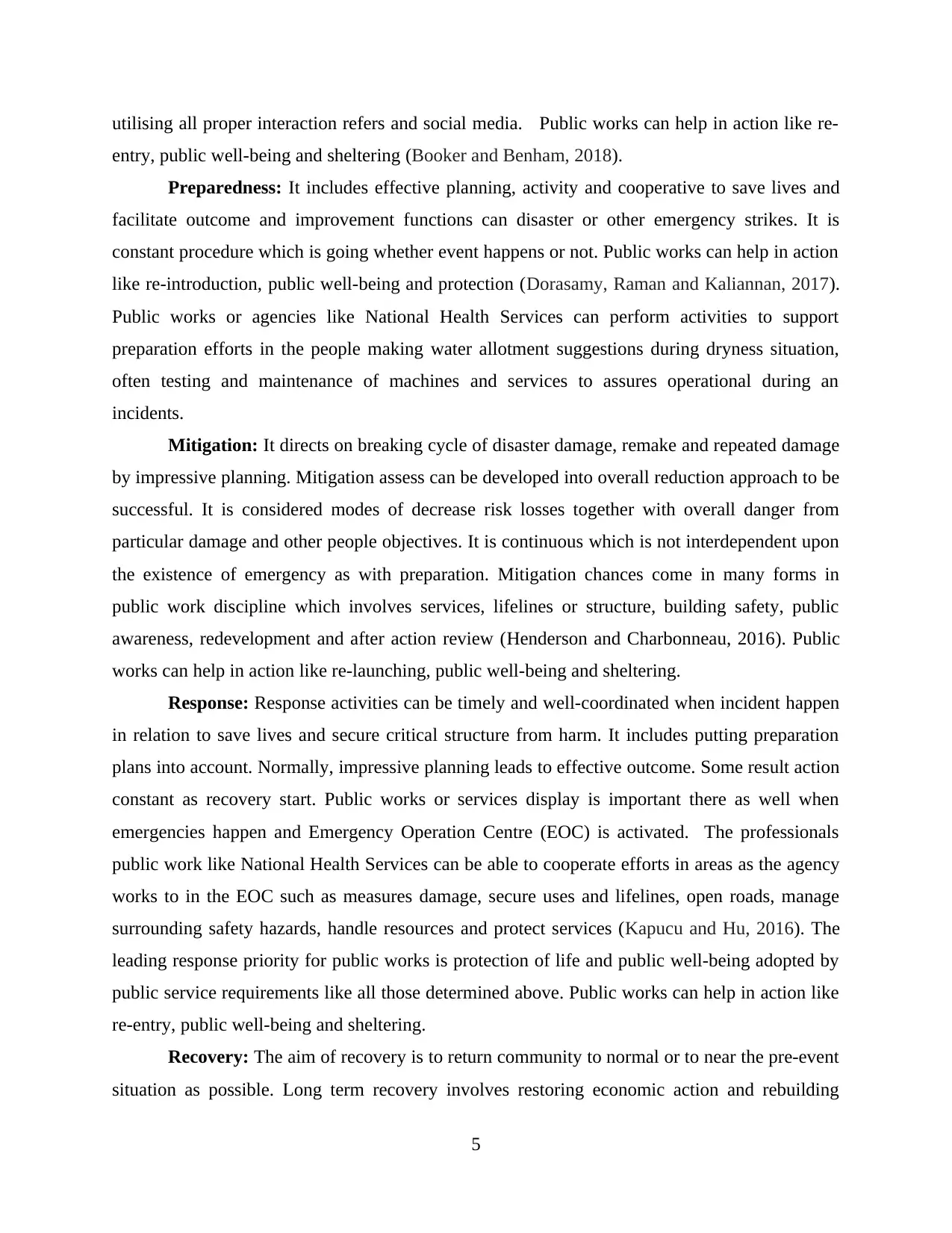
utilising all proper interaction refers and social media. Public works can help in action like re-
entry, public well-being and sheltering (Booker and Benham, 2018).
Preparedness: It includes effective planning, activity and cooperative to save lives and
facilitate outcome and improvement functions can disaster or other emergency strikes. It is
constant procedure which is going whether event happens or not. Public works can help in action
like re-introduction, public well-being and protection (Dorasamy, Raman and Kaliannan, 2017).
Public works or agencies like National Health Services can perform activities to support
preparation efforts in the people making water allotment suggestions during dryness situation,
often testing and maintenance of machines and services to assures operational during an
incidents.
Mitigation: It directs on breaking cycle of disaster damage, remake and repeated damage
by impressive planning. Mitigation assess can be developed into overall reduction approach to be
successful. It is considered modes of decrease risk losses together with overall danger from
particular damage and other people objectives. It is continuous which is not interdependent upon
the existence of emergency as with preparation. Mitigation chances come in many forms in
public work discipline which involves services, lifelines or structure, building safety, public
awareness, redevelopment and after action review (Henderson and Charbonneau, 2016). Public
works can help in action like re-launching, public well-being and sheltering.
Response: Response activities can be timely and well-coordinated when incident happen
in relation to save lives and secure critical structure from harm. It includes putting preparation
plans into account. Normally, impressive planning leads to effective outcome. Some result action
constant as recovery start. Public works or services display is important there as well when
emergencies happen and Emergency Operation Centre (EOC) is activated. The professionals
public work like National Health Services can be able to cooperate efforts in areas as the agency
works to in the EOC such as measures damage, secure uses and lifelines, open roads, manage
surrounding safety hazards, handle resources and protect services (Kapucu and Hu, 2016). The
leading response priority for public works is protection of life and public well-being adopted by
public service requirements like all those determined above. Public works can help in action like
re-entry, public well-being and sheltering.
Recovery: The aim of recovery is to return community to normal or to near the pre-event
situation as possible. Long term recovery involves restoring economic action and rebuilding
5
entry, public well-being and sheltering (Booker and Benham, 2018).
Preparedness: It includes effective planning, activity and cooperative to save lives and
facilitate outcome and improvement functions can disaster or other emergency strikes. It is
constant procedure which is going whether event happens or not. Public works can help in action
like re-introduction, public well-being and protection (Dorasamy, Raman and Kaliannan, 2017).
Public works or agencies like National Health Services can perform activities to support
preparation efforts in the people making water allotment suggestions during dryness situation,
often testing and maintenance of machines and services to assures operational during an
incidents.
Mitigation: It directs on breaking cycle of disaster damage, remake and repeated damage
by impressive planning. Mitigation assess can be developed into overall reduction approach to be
successful. It is considered modes of decrease risk losses together with overall danger from
particular damage and other people objectives. It is continuous which is not interdependent upon
the existence of emergency as with preparation. Mitigation chances come in many forms in
public work discipline which involves services, lifelines or structure, building safety, public
awareness, redevelopment and after action review (Henderson and Charbonneau, 2016). Public
works can help in action like re-launching, public well-being and sheltering.
Response: Response activities can be timely and well-coordinated when incident happen
in relation to save lives and secure critical structure from harm. It includes putting preparation
plans into account. Normally, impressive planning leads to effective outcome. Some result action
constant as recovery start. Public works or services display is important there as well when
emergencies happen and Emergency Operation Centre (EOC) is activated. The professionals
public work like National Health Services can be able to cooperate efforts in areas as the agency
works to in the EOC such as measures damage, secure uses and lifelines, open roads, manage
surrounding safety hazards, handle resources and protect services (Kapucu and Hu, 2016). The
leading response priority for public works is protection of life and public well-being adopted by
public service requirements like all those determined above. Public works can help in action like
re-entry, public well-being and sheltering.
Recovery: The aim of recovery is to return community to normal or to near the pre-event
situation as possible. Long term recovery involves restoring economic action and rebuilding
5
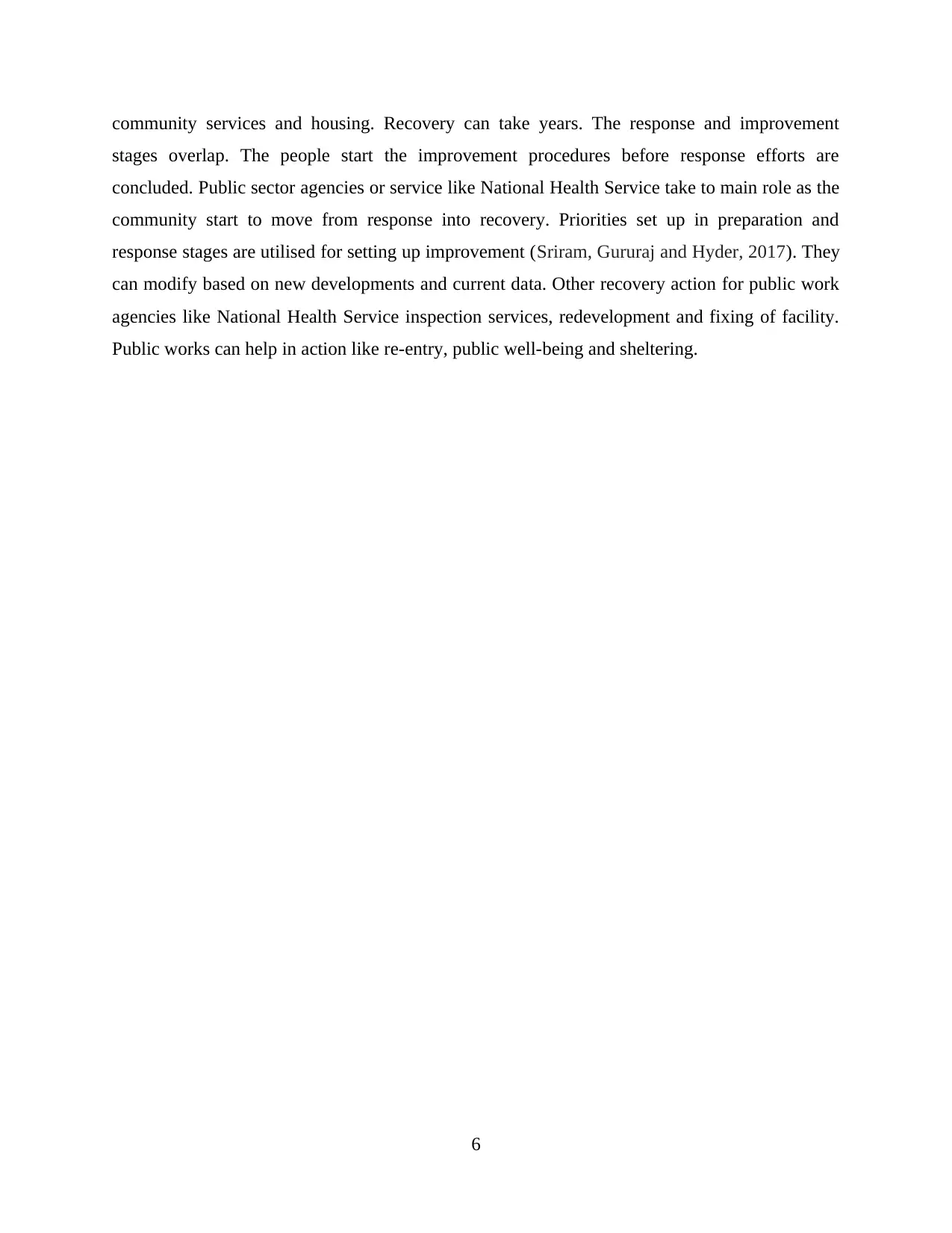
community services and housing. Recovery can take years. The response and improvement
stages overlap. The people start the improvement procedures before response efforts are
concluded. Public sector agencies or service like National Health Service take to main role as the
community start to move from response into recovery. Priorities set up in preparation and
response stages are utilised for setting up improvement (Sriram, Gururaj and Hyder, 2017). They
can modify based on new developments and current data. Other recovery action for public work
agencies like National Health Service inspection services, redevelopment and fixing of facility.
Public works can help in action like re-entry, public well-being and sheltering.
6
stages overlap. The people start the improvement procedures before response efforts are
concluded. Public sector agencies or service like National Health Service take to main role as the
community start to move from response into recovery. Priorities set up in preparation and
response stages are utilised for setting up improvement (Sriram, Gururaj and Hyder, 2017). They
can modify based on new developments and current data. Other recovery action for public work
agencies like National Health Service inspection services, redevelopment and fixing of facility.
Public works can help in action like re-entry, public well-being and sheltering.
6
⊘ This is a preview!⊘
Do you want full access?
Subscribe today to unlock all pages.

Trusted by 1+ million students worldwide
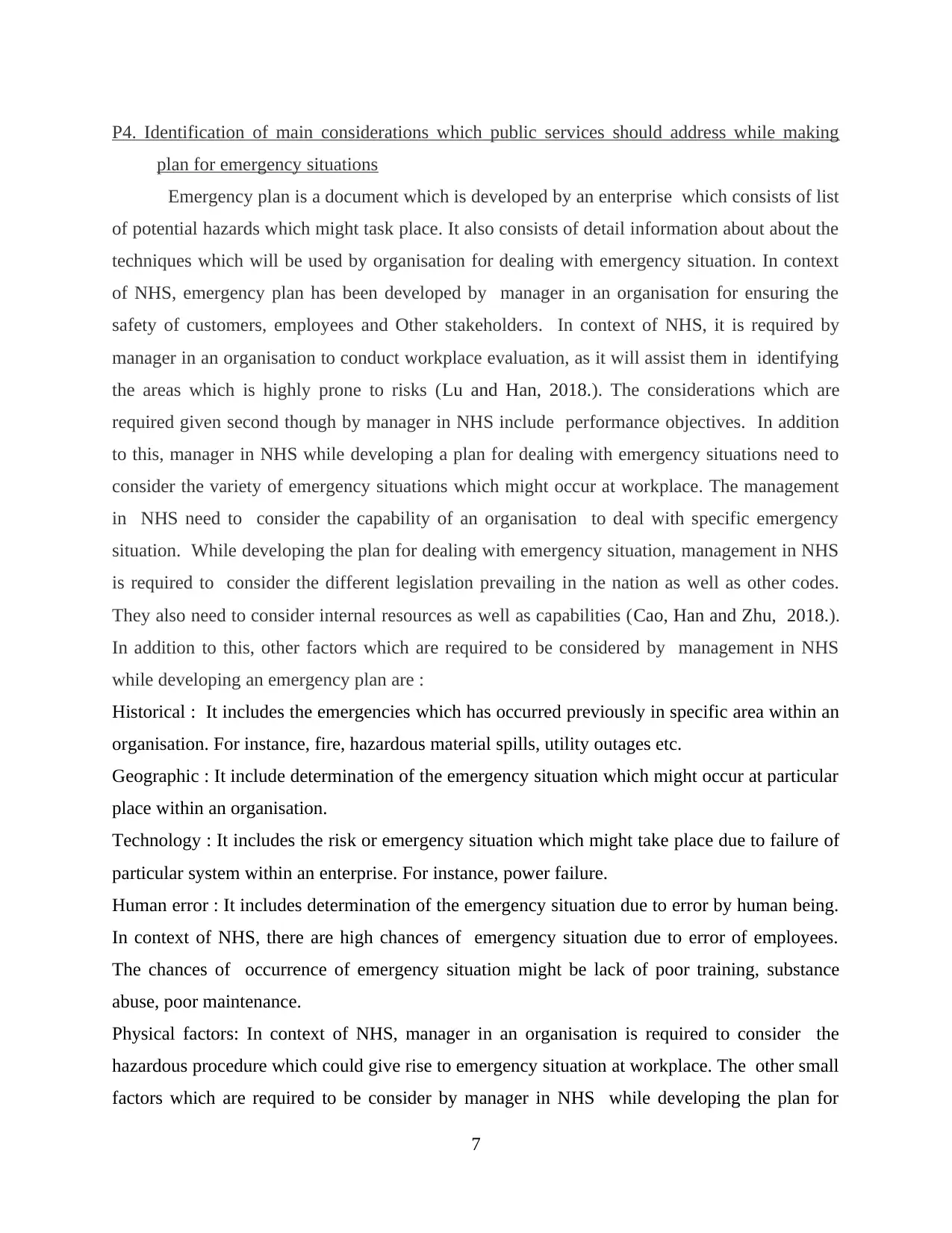
P4. Identification of main considerations which public services should address while making
plan for emergency situations
Emergency plan is a document which is developed by an enterprise which consists of list
of potential hazards which might task place. It also consists of detail information about about the
techniques which will be used by organisation for dealing with emergency situation. In context
of NHS, emergency plan has been developed by manager in an organisation for ensuring the
safety of customers, employees and Other stakeholders. In context of NHS, it is required by
manager in an organisation to conduct workplace evaluation, as it will assist them in identifying
the areas which is highly prone to risks (Lu and Han, 2018.). The considerations which are
required given second though by manager in NHS include performance objectives. In addition
to this, manager in NHS while developing a plan for dealing with emergency situations need to
consider the variety of emergency situations which might occur at workplace. The management
in NHS need to consider the capability of an organisation to deal with specific emergency
situation. While developing the plan for dealing with emergency situation, management in NHS
is required to consider the different legislation prevailing in the nation as well as other codes.
They also need to consider internal resources as well as capabilities (Cao, Han and Zhu, 2018.).
In addition to this, other factors which are required to be considered by management in NHS
while developing an emergency plan are :
Historical : It includes the emergencies which has occurred previously in specific area within an
organisation. For instance, fire, hazardous material spills, utility outages etc.
Geographic : It include determination of the emergency situation which might occur at particular
place within an organisation.
Technology : It includes the risk or emergency situation which might take place due to failure of
particular system within an enterprise. For instance, power failure.
Human error : It includes determination of the emergency situation due to error by human being.
In context of NHS, there are high chances of emergency situation due to error of employees.
The chances of occurrence of emergency situation might be lack of poor training, substance
abuse, poor maintenance.
Physical factors: In context of NHS, manager in an organisation is required to consider the
hazardous procedure which could give rise to emergency situation at workplace. The other small
factors which are required to be consider by manager in NHS while developing the plan for
7
plan for emergency situations
Emergency plan is a document which is developed by an enterprise which consists of list
of potential hazards which might task place. It also consists of detail information about about the
techniques which will be used by organisation for dealing with emergency situation. In context
of NHS, emergency plan has been developed by manager in an organisation for ensuring the
safety of customers, employees and Other stakeholders. In context of NHS, it is required by
manager in an organisation to conduct workplace evaluation, as it will assist them in identifying
the areas which is highly prone to risks (Lu and Han, 2018.). The considerations which are
required given second though by manager in NHS include performance objectives. In addition
to this, manager in NHS while developing a plan for dealing with emergency situations need to
consider the variety of emergency situations which might occur at workplace. The management
in NHS need to consider the capability of an organisation to deal with specific emergency
situation. While developing the plan for dealing with emergency situation, management in NHS
is required to consider the different legislation prevailing in the nation as well as other codes.
They also need to consider internal resources as well as capabilities (Cao, Han and Zhu, 2018.).
In addition to this, other factors which are required to be considered by management in NHS
while developing an emergency plan are :
Historical : It includes the emergencies which has occurred previously in specific area within an
organisation. For instance, fire, hazardous material spills, utility outages etc.
Geographic : It include determination of the emergency situation which might occur at particular
place within an organisation.
Technology : It includes the risk or emergency situation which might take place due to failure of
particular system within an enterprise. For instance, power failure.
Human error : It includes determination of the emergency situation due to error by human being.
In context of NHS, there are high chances of emergency situation due to error of employees.
The chances of occurrence of emergency situation might be lack of poor training, substance
abuse, poor maintenance.
Physical factors: In context of NHS, manager in an organisation is required to consider the
hazardous procedure which could give rise to emergency situation at workplace. The other small
factors which are required to be consider by manager in NHS while developing the plan for
7
Paraphrase This Document
Need a fresh take? Get an instant paraphrase of this document with our AI Paraphraser
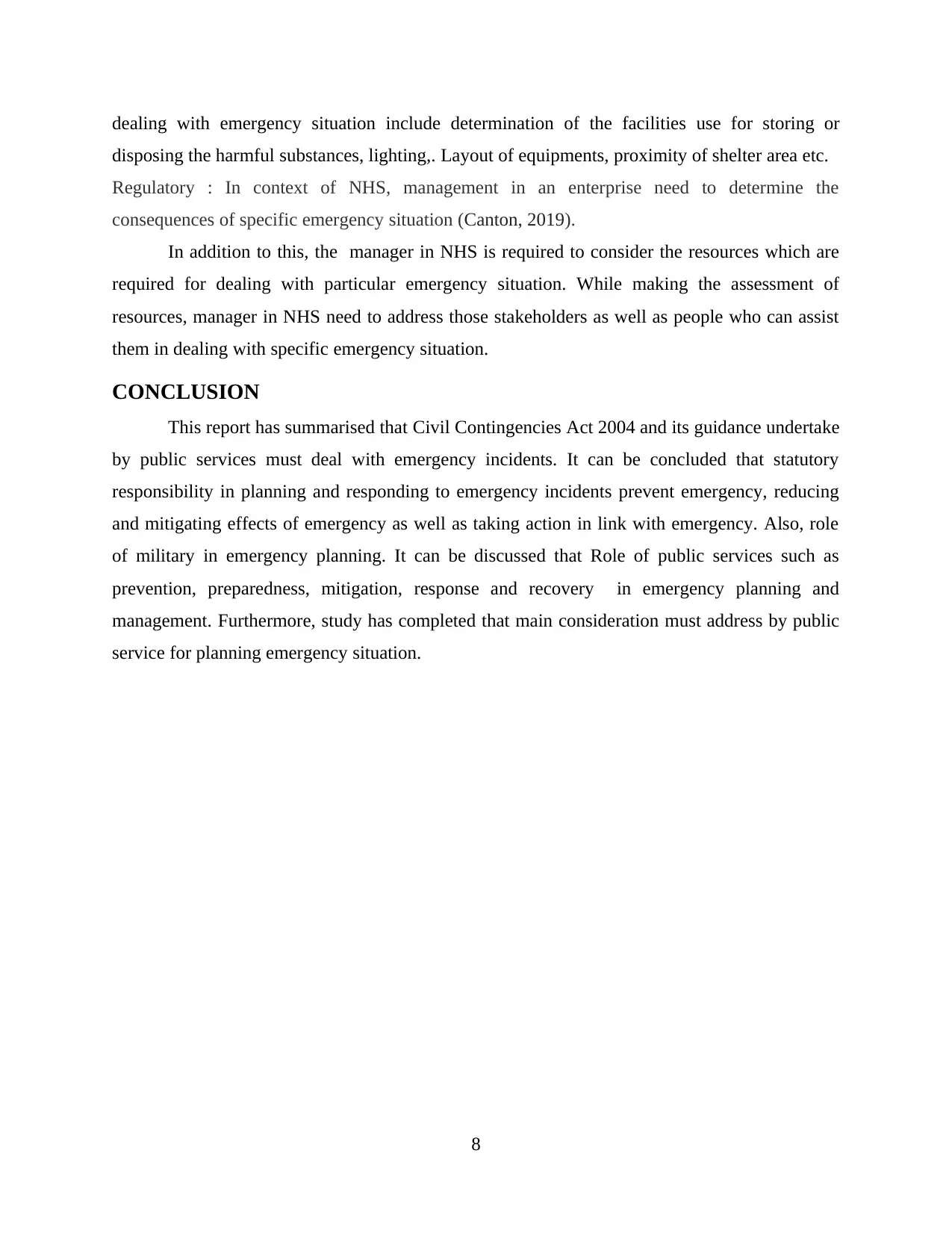
dealing with emergency situation include determination of the facilities use for storing or
disposing the harmful substances, lighting,. Layout of equipments, proximity of shelter area etc.
Regulatory : In context of NHS, management in an enterprise need to determine the
consequences of specific emergency situation (Canton, 2019).
In addition to this, the manager in NHS is required to consider the resources which are
required for dealing with particular emergency situation. While making the assessment of
resources, manager in NHS need to address those stakeholders as well as people who can assist
them in dealing with specific emergency situation.
CONCLUSION
This report has summarised that Civil Contingencies Act 2004 and its guidance undertake
by public services must deal with emergency incidents. It can be concluded that statutory
responsibility in planning and responding to emergency incidents prevent emergency, reducing
and mitigating effects of emergency as well as taking action in link with emergency. Also, role
of military in emergency planning. It can be discussed that Role of public services such as
prevention, preparedness, mitigation, response and recovery in emergency planning and
management. Furthermore, study has completed that main consideration must address by public
service for planning emergency situation.
8
disposing the harmful substances, lighting,. Layout of equipments, proximity of shelter area etc.
Regulatory : In context of NHS, management in an enterprise need to determine the
consequences of specific emergency situation (Canton, 2019).
In addition to this, the manager in NHS is required to consider the resources which are
required for dealing with particular emergency situation. While making the assessment of
resources, manager in NHS need to address those stakeholders as well as people who can assist
them in dealing with specific emergency situation.
CONCLUSION
This report has summarised that Civil Contingencies Act 2004 and its guidance undertake
by public services must deal with emergency incidents. It can be concluded that statutory
responsibility in planning and responding to emergency incidents prevent emergency, reducing
and mitigating effects of emergency as well as taking action in link with emergency. Also, role
of military in emergency planning. It can be discussed that Role of public services such as
prevention, preparedness, mitigation, response and recovery in emergency planning and
management. Furthermore, study has completed that main consideration must address by public
service for planning emergency situation.
8
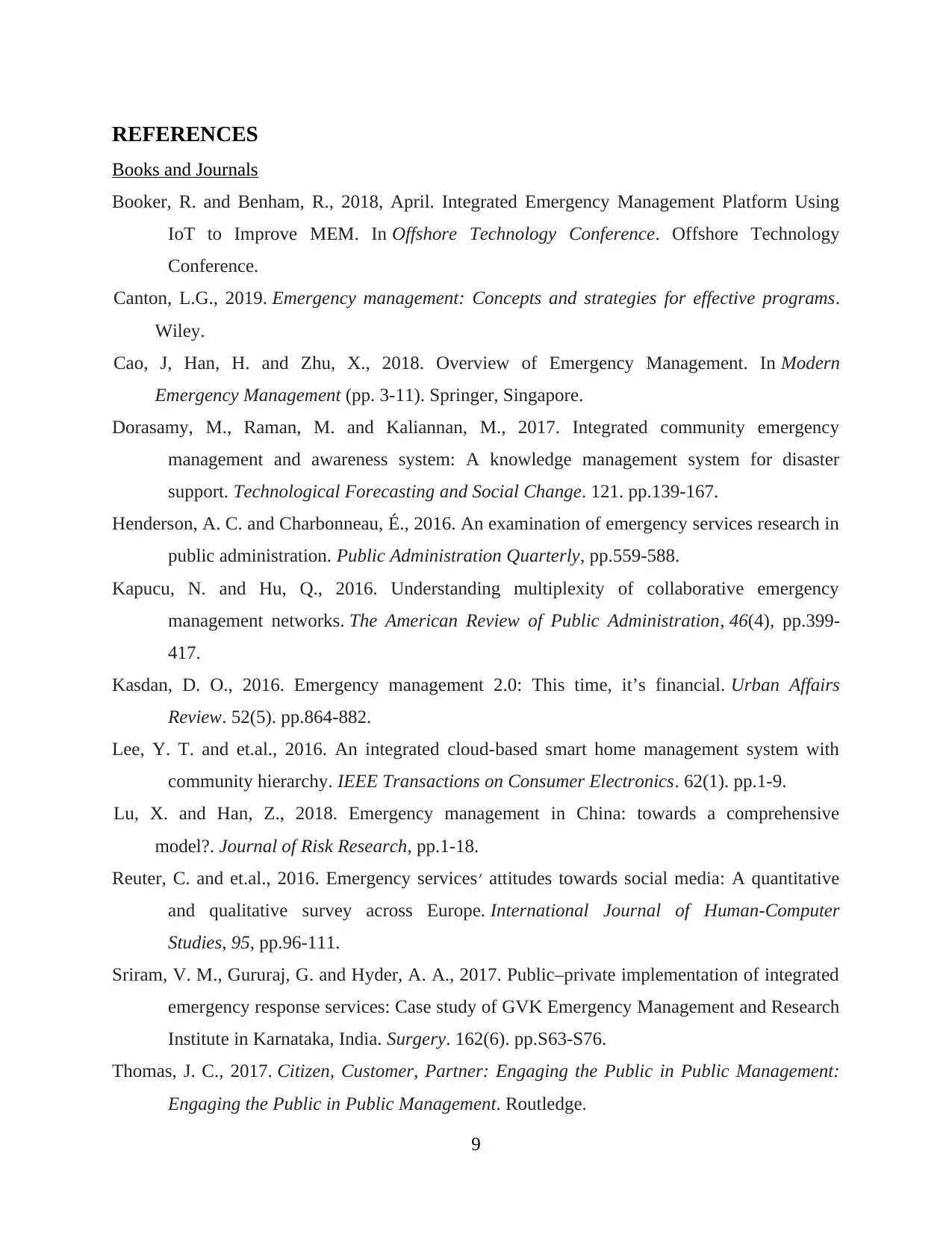
REFERENCES
Books and Journals
Booker, R. and Benham, R., 2018, April. Integrated Emergency Management Platform Using
IoT to Improve MEM. In Offshore Technology Conference. Offshore Technology
Conference.
Canton, L.G., 2019. Emergency management: Concepts and strategies for effective programs.
Wiley.
Cao, J, Han, H. and Zhu, X., 2018. Overview of Emergency Management. In Modern
Emergency Management (pp. 3-11). Springer, Singapore.
Dorasamy, M., Raman, M. and Kaliannan, M., 2017. Integrated community emergency
management and awareness system: A knowledge management system for disaster
support. Technological Forecasting and Social Change. 121. pp.139-167.
Henderson, A. C. and Charbonneau, É., 2016. An examination of emergency services research in
public administration. Public Administration Quarterly, pp.559-588.
Kapucu, N. and Hu, Q., 2016. Understanding multiplexity of collaborative emergency
management networks. The American Review of Public Administration, 46(4), pp.399-
417.
Kasdan, D. O., 2016. Emergency management 2.0: This time, it’s financial. Urban Affairs
Review. 52(5). pp.864-882.
Lee, Y. T. and et.al., 2016. An integrated cloud-based smart home management system with
community hierarchy. IEEE Transactions on Consumer Electronics. 62(1). pp.1-9.
Lu, X. and Han, Z., 2018. Emergency management in China: towards a comprehensive
model?. Journal of Risk Research, pp.1-18.
Reuter, C. and et.al., 2016. Emergency services׳ attitudes towards social media: A quantitative
and qualitative survey across Europe. International Journal of Human-Computer
Studies, 95, pp.96-111.
Sriram, V. M., Gururaj, G. and Hyder, A. A., 2017. Public–private implementation of integrated
emergency response services: Case study of GVK Emergency Management and Research
Institute in Karnataka, India. Surgery. 162(6). pp.S63-S76.
Thomas, J. C., 2017. Citizen, Customer, Partner: Engaging the Public in Public Management:
Engaging the Public in Public Management. Routledge.
9
Books and Journals
Booker, R. and Benham, R., 2018, April. Integrated Emergency Management Platform Using
IoT to Improve MEM. In Offshore Technology Conference. Offshore Technology
Conference.
Canton, L.G., 2019. Emergency management: Concepts and strategies for effective programs.
Wiley.
Cao, J, Han, H. and Zhu, X., 2018. Overview of Emergency Management. In Modern
Emergency Management (pp. 3-11). Springer, Singapore.
Dorasamy, M., Raman, M. and Kaliannan, M., 2017. Integrated community emergency
management and awareness system: A knowledge management system for disaster
support. Technological Forecasting and Social Change. 121. pp.139-167.
Henderson, A. C. and Charbonneau, É., 2016. An examination of emergency services research in
public administration. Public Administration Quarterly, pp.559-588.
Kapucu, N. and Hu, Q., 2016. Understanding multiplexity of collaborative emergency
management networks. The American Review of Public Administration, 46(4), pp.399-
417.
Kasdan, D. O., 2016. Emergency management 2.0: This time, it’s financial. Urban Affairs
Review. 52(5). pp.864-882.
Lee, Y. T. and et.al., 2016. An integrated cloud-based smart home management system with
community hierarchy. IEEE Transactions on Consumer Electronics. 62(1). pp.1-9.
Lu, X. and Han, Z., 2018. Emergency management in China: towards a comprehensive
model?. Journal of Risk Research, pp.1-18.
Reuter, C. and et.al., 2016. Emergency services׳ attitudes towards social media: A quantitative
and qualitative survey across Europe. International Journal of Human-Computer
Studies, 95, pp.96-111.
Sriram, V. M., Gururaj, G. and Hyder, A. A., 2017. Public–private implementation of integrated
emergency response services: Case study of GVK Emergency Management and Research
Institute in Karnataka, India. Surgery. 162(6). pp.S63-S76.
Thomas, J. C., 2017. Citizen, Customer, Partner: Engaging the Public in Public Management:
Engaging the Public in Public Management. Routledge.
9
⊘ This is a preview!⊘
Do you want full access?
Subscribe today to unlock all pages.

Trusted by 1+ million students worldwide
1 out of 13
Related Documents
Your All-in-One AI-Powered Toolkit for Academic Success.
+13062052269
info@desklib.com
Available 24*7 on WhatsApp / Email
![[object Object]](/_next/static/media/star-bottom.7253800d.svg)
Unlock your academic potential
Copyright © 2020–2025 A2Z Services. All Rights Reserved. Developed and managed by ZUCOL.



